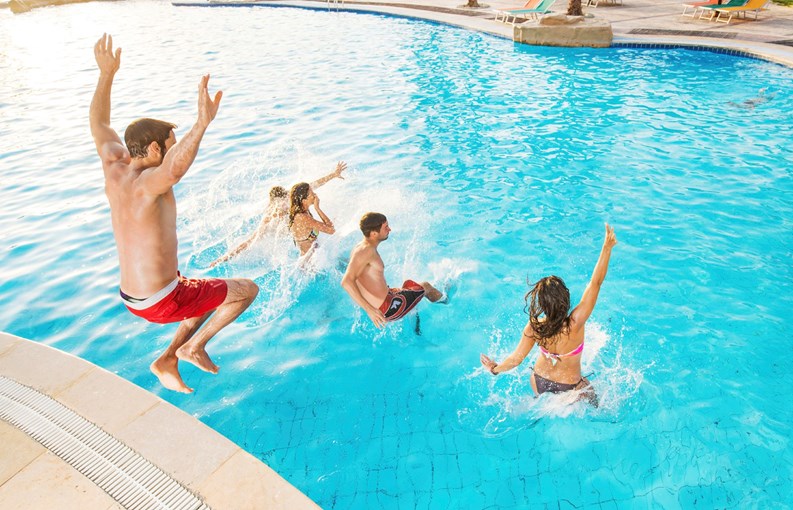Some lucky co-ops and condos offer the benefits of an indoor or outdoor swimming pool for their residents; it’s a splashy amenity that many people request when looking for a home…but there are many drawbacks, issues, and liabilities that come with managing a pool.
Anyone who is considering living in a building with a pool, or thinking of running for the board in a building with a pool, should learn about safety measures, diving boards, and other pools feature before diving in.
Pooling Concerns
Indeed, there are serious dangers involved with co-op, condo and HOA pools. From 2005 to 2007, there were 385 pool-related drownings for children younger than 15, and from 2007 to 2009, there were an average of 4,200 emergency department-treated submersions for children younger than the age of 15, according to the U.S. Consumer Product Safety Commission (CPSC).
Shockingly, 54 percent of the injuries from 2007 to 2009 and 74 percent of the fatalities between 2005 and 2007 (involving children younger than 15) occurred at a residence.
A Need for Change
“Educating communities on the potential dangers of swimming pools is a critical tool in saving the lives of our children,” says Florida Congresswoman Debbie Wasserman Schultz, D-23, the author of the Virginia Graeme Baker Pool and Spa Safety Act.
The result of a tragic accident in June 2002, the Virginia Graeme Baker Pool and Spa Safety Act was introduced after suction from a Jacuzzi drain trapped the 7-year-old granddaughter of former Secretary of State James Baker III under water; it took two men to pull her from the drain, but it happened too late and she drowned.
Virginia’s mother, Nancy Baker, advocated for pool and spa safety and won support for a law requiring anti-entrapment drain covers and other safety devices. It was enacted by Congress and signed by President Bush in 2007, and became law in 2008. It prevents hidden hazards of drain entrapment in pools and spas. “I understand the need to bring together the public and dedicated partners in the water safety community to begin a national conversation about water safety,” Baker says.
Despite that law going into action, there was a similar pool drain accident in a Key Biscayne, Florida condo pool in 2009 after a 3-year-old girl’s arm was trapped in a skimmer drain. Fortunately, she survived the accident; though, if the pool had installed the new domed-shaped drains or large flat drains resulting from the VGB Pool and Spa Safety Act, then chances are, the girl wouldn’t have become stuck, officials said.
In addition to using anti-entrapment drain covers, sonars can be added for safety, says Stuart Roaker, president of The Pool Therapist, a pool management company based in Staten Island. If someone swims after hours—or if they fall into the pool when no lifeguard is on duty—an alarm goes off.
“A lot of times, people can hop fences, and when they do so, no one will know,” Roaker says. “If they have special devices that differentiate between a squirrel and a person, this could be lifesaving.”
While items like sonar are optional, there are many potentially lifesaving safety devices and requirements that are required in the state of New York. In fact, state law mandates specific rules and regulations that make swimming even safer; though, these rules are more expensive—and complicated—to operate a pool in a condo setting, Roaker says. Most importantly, a lifeguard must be present at all times the pool is open: one lifeguard per 75 people (or one lifeguard per 25 feet).
Overflowing Costs
However, Roaker recommends having two lifeguards on duty during pool hours. “What happens if the lifeguard is going to be checking the passes? Then you need another lifeguard,” he says. New York law mandates that you temporarily shut down the pool if you only have one lifeguard, and that lifeguard has to go to the bathroom.
“But that’s embarrassing,” Roaker says. “What they usually do is rotate. Also, based on how crowded the pool is, the lifeguard may not be able to leave his spot.”
Lifeguards aren’t the only major mandate in New York. The state’s pool laws regulate fencing around outdoor pools, as well; for indoor pools, one entrance to the pool is required, and it must be secure at all times.
“If you don’t have a single entrance, you would have to double the staff,” Roaker says. This is to ensure the lifeguard knows where everyone is, and doesn’t think that someone has left the pool area when they are, in fact, under water.
Deciding to ignore a pool law can be incredibly costly. The New York Board of Health will fine a condo or residence up to $2,000 per violation, and they do random checks (at least) twice per summer for outdoor pools, and at random times for indoor pools, Roaker says. It’s up to the pool owner or manager to stay up to date with the rules and regulations.
New Rules and Regulations
The No Prolonged Breath-Holding Under Water rule is a new regulation. This came into effect after two 21-year-old men died in 2011 while swimming—with lifeguards present—in New York as they participated in a breath-holding contest but they both passed out, triggering their bodies to react, forcing them to breathe. This caused their lungs to fill with water, and they suffered from shallow water blackout…and died.
Ironically, one of the men was a New York City-based lifeguard enlisted in the Air Force, training for an elite para-rescue unit; the other was preparing for enlistment in the Marine Corps. The new rule mandates that New York pools must have signs posted saying that prolonged breath holding under water is not permitted.
One thing that’s not illegal—albeit rare—is diving boards and water slides. While they’re allowed in condo pools and private residence pools, they’re frowned upon by insurance companies. In fact, they drive up insurance rates significantly, and many condos or residences that had them in the past have now removed them, along with their deep portions of the pools.
“Most pools are now 5 feet or under because insurance companies don’t want diving boards…there are too many spinal cord injuries, and in older pools, they took the diving boards out,” Roaker says. “New York is very strict when it comes to things like this. About 15 years ago, they started getting rid of the diving boards, so now you only have them at swim clubs and universities.”
More Ways to Save
While operating a pool is an incredibly expensive ordeal, there are ways to reduce costs. For instance, one can limit the number of hours a pool is open, thus, paying for fewer lifeguard hours. Insurance rates will go down, largely because such rates are determined by the number of hours the pool is in operation.
In New York, peak hours of pool operation are from 12 p.m. to 8 p.m. during the week and from 11 a.m. to 7 p.m. on weekends and on holidays. “That’s when the majority of communities like to be open for the pools,” Roaker says. “This way, they get a chance after dinner to go for a swim, and on the weekends.”
Licensing in New York
The Department of Public Health mandates that qualified swimming pool water treatment operators maintain pools larger than 3,000 square feet, or those that are disinfected using gas chlorine, or are recreational aquatic spray ground facilities.
The pool operator completes daily operation records for the pool and keeps a record of those forms at the facility for 12 months. The records include everything from chlorine levels, water testing frequency, pH testing, water clarity, bather load, depth markings, cyanuric acid levels, and CPO required.
In order to become a pool operations manager, one has to enroll in a two-day course followed by an open book written test at an approved site. The certification course teaches individuals basic knowledge and techniques of pool and spa operations so they are able to maintain the pool and satisfy the state requirements. The CPO certification is valid for 5 years.
Learn more about the course and the requirements at www.pooloperation management.com. However, having a qualified water treatment operator isn’t all that is required. Many licensing requirements are outlined by the New York Board of Health to assure that a pool is sanitary, healthful, and a safe environment. Thus, Roaker recommends that condos secure a management company as soon as they acquire a pool. The management company will ensure each requirement is followed.
The person managing the pool needs to know that bathrooms must be provided, except when bathrooms are available within 300 feet of the pool, or within one floor above or below the pool. All showers should must reach a temperature of at least 90 degrees, and no more than 110 at a rate of at least 1½ gallons per minute per showerhead.
These are all issues that the manager would handle…taking the headache away from the building itself.
Danielle Braff is a freelance writer and a frequent contributor to The Cooperator.







Leave a Comment